The use of artificial flowers in the interior
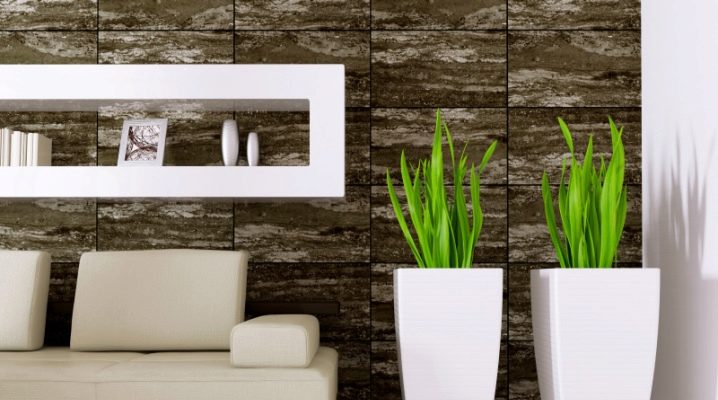
Artificial flowers for home interiors are often chosen simply to diversify the decorative design of the living space. Among the obvious advantages of this decor option are ease of care, versatility and a variety of available solutions. Unlike the primitive options found everywhere on sale, modern floristic compositions definitely pretend to be graceful and chic. Moreover, it has become fashionable to make flower arrangements from decorative bouquets with your own hands, to form original ikebana in floor pots, to hang large and beautiful pots on the wall.
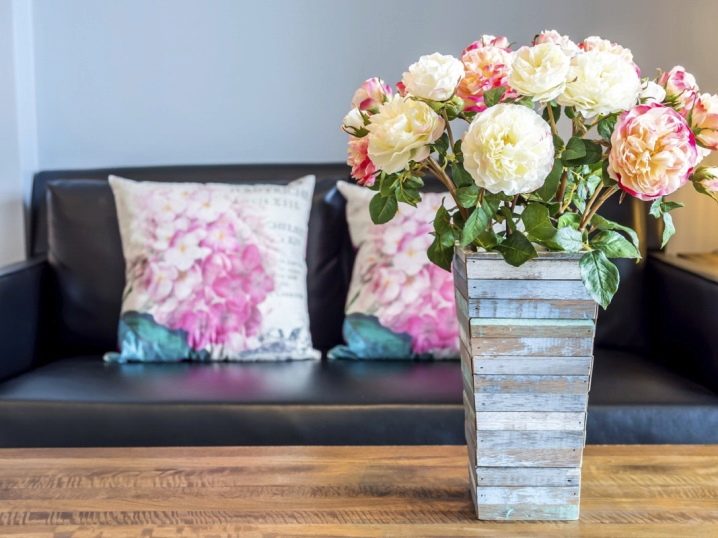
Advantages and disadvantages
It is generally accepted that artificial flowers in the interior can always be distinguished from living ones. But upon closer examination, it turns out that even professional decorators are not always capable of such a task. And here's why: perfecting the flower arrangements used in the interior, their creators have managed to achieve amazing success. Today, artificial flowers serve as the best decoration for living quarters and may well become a symbol of home comfort. Among their obvious advantages are the following.
- Minimal care. Dust removal is sufficient. Even without feeding, watering or regularly replacing plants in vases, the house will always be beautiful.
- No problem of departures and business trips. You can forget about drip irrigation systems or asking friends and neighbors to water.
- Minimizing the risks of developing allergies. It's simple - there is no pollen, which means there is no negative reaction to it.
- Lack of insects. Plants in the house are at increased risk of attracting harmful parasites, which are very difficult to get rid of. In addition, wasps, bees and hornets can attack them during the flowering period.
- Ease of forming aesthetic compositions in the interior. Even without understanding floristry and color combinations, you can create a beautiful composition.
- Wide range of accommodation options - in vases, flowerpots, pots, baskets, wreaths.
- The ability to place in any room at home or outdoors, balcony, terrace.
- Guaranteed safety for children and animals.
- Ease of changing your place of residence - The transportation of flowers in the ground often turns into a multi-week epic, fraught with a lot of difficulties.


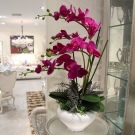
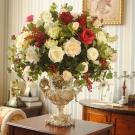
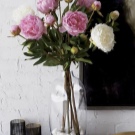
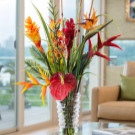
But there are some drawbacks here. The main one is the lack of aroma, but for allergy sufferers, such a minus can be an advantage. Burnout of petals upon contact with the sun can also be attributed to the disadvantages of fresh flowers. What is definitely worth mentioning is the presence of low quality products on the market. You can buy cheap products that can shed in a humid environment, cause allergies, or fill a room with an unpleasant chemical scent.

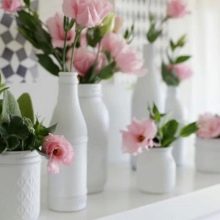
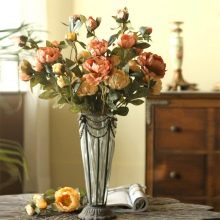
Otherwise, artificial flowers are almost perfect, because, unlike living plants, their beauty is practically not lost over time. And to solve the problem of smell, you can use essential oils.
How to choose?
There is no single right choice rule. Decorative compositions and artificial flowers are as individual as their natural counterparts. But the quality of workmanship directly depends on the scale of the product. Small flowers are more detailed. In addition, it is worth paying attention to their design in the area of the stem - here everything should also be as reliable as possible, especially if they are to be placed around the house in transparent glass vessels.
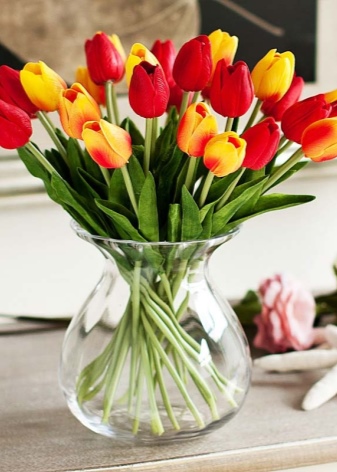
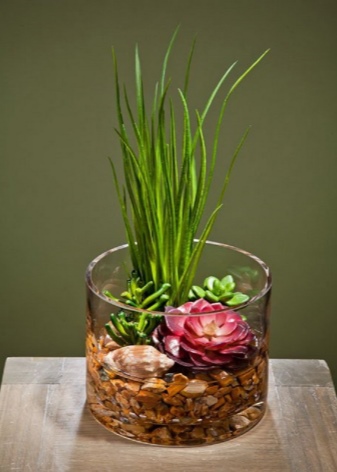
The matt and glossy containers in pure white are a real hit in interior design. In combination with such a frame, you can create a Japanese ikebana, and a wedding composition, or set off the interior decoration of the living room. Floor vases and flowerpots are also in fashion - they place imitation of flowering trees or flowers on high stems - roses, calla lilies, lilies, gladioli. In the bedroom, compositions on windows in low containers, with straight stems and large inflorescences or very small ones, will be more appropriate.
Glass laboratory flasks, lined up with orchids inside, look interesting.
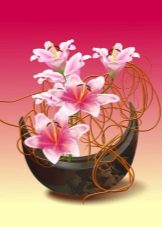
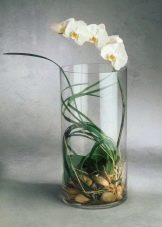
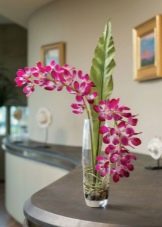
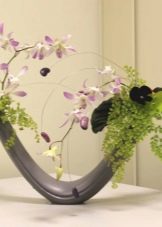
When choosing artificial flowers for placement in the interior, it is worth considering the general style of the space. Minimalism is well set off by the freshness of multi-colored tulips collected in bouquets or free-standing exotic plants. Baroque and rococo demand pomp, but each style has its own color scheme. For example, the baroque variegation and richness of colors will pleasantly set off the use of raspberry peonies or spray roses. For interiors in the Rococo spirit, you can use yellow and cream roses.

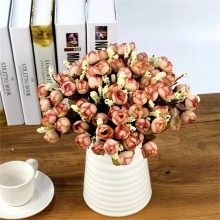
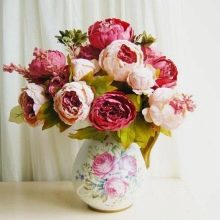
Flower arrangements
Unusual flower arrangements in the interior can be easily created with your own hands. For this, simple design techniques are used to securely fix all the elements of the composition. The following solutions are considered the most popular today.
- Compositions in pots. Among them there are very realistic copies of popular indoor species, as well as flowers that are more common to see in a flower bed. Climbing plants are most often used to mask communications or unsuccessful repairs. In niches, ledges, corners, large floor vases are appropriate, in which ficuses, palms, dwarf trees with spherical crowns are placed. The main difference between the compositions in pots is the predominance of greenery. It is almost impossible to find flowering variants here.
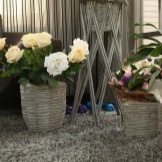
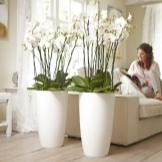
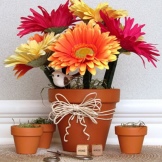
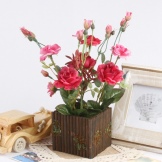
- Bouquets in glass vases. Beautiful designer bouquets, placed in vases, always look elegant and solemn. Moreover, both classic tabletop options and high floor elements with a massive base are equally popular. It is customary to fill wide vessels with small carnations or other flowers with lush foliage and an abundant number of inflorescences. Tall and medium vases without unnecessary decorations are ideal for arranging tulips, roses, lilies, gerberas. The resemblance to natural flowers will enhance the presence of water in the container. Don't keep the same song all year round. Asters look great in vases in autumn, peonies in summer, chamomile, tulips and other early flowers can be used in spring.
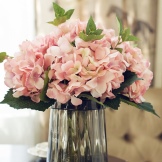
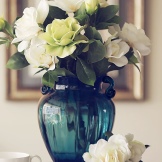
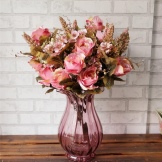
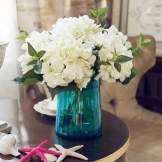
- Biedermeier. Such bouquets are often placed in the interior during pre-holiday preparations. It is customary to create perfectly round compositions of repeating elements in white or pink colors. They complement the space of a bedroom or living room, decorate halls for a wedding. A spherical composition requires the formation of a bouquet without unnecessary elements - protruding leaves and stems are unacceptable. But white gypsophila or spikelets will look quite advantageous in such a composition.
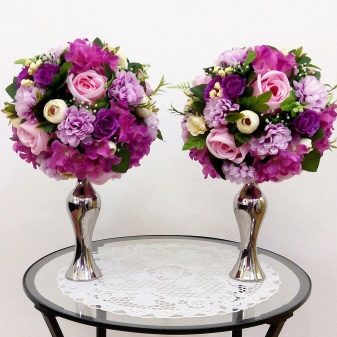
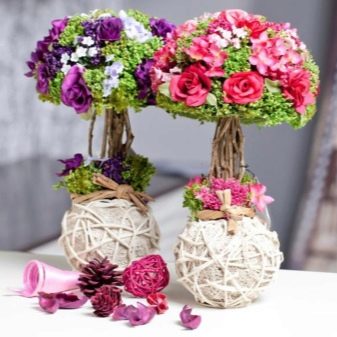
- Panel on the wall. Wall panels are a trendy trend in interior decoration with artificial flowers. The base with moss, herbs, flowers and fruits is fixed in a floral sponge. It is possible to perform ikebana on the wall in this style. It is characterized by a choice of emphasized natural elements, a laconic color scheme that imitates a green carpet or a clearing in the forest.
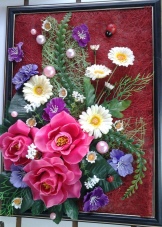
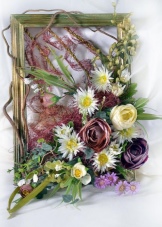
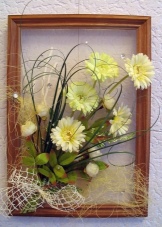
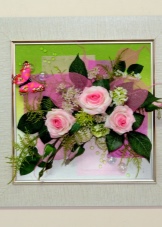
- Cache-pot. Wall hanging mounts are a fairly popular option. They are used in combination with high ceiling beams to create a cozy home environment.Such compositions are appropriate on walls or windows, on a terrace and balcony. A basket or a ceramic pot placed in a stand can be used as a suspension. Such solutions are especially good in combination with Provence or country style.
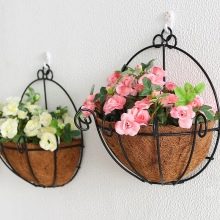
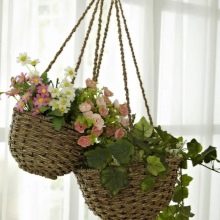
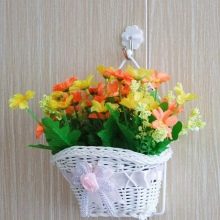
Use in various rooms
There are no prohibitions on the use of artificial flowers in a modern interior today - you can afford any experiments. In addition, there is the possibility of making various combinations of live and artificial plants. But there are certain rules that make it much faster and easier to choose a decor option for each room based on its characteristics and purpose.
- Into the hallway it is worth placing plants that are as laconic as possible in their appearance. If the height of the ceilings allows, you can choose a liana or pots with bindweed. Tall, straight bamboo stalks in simple rectangular containers will also look great on the floor, especially in multi-level space planning. But there is one important detail: it is worth placing flowers only in those rooms where repairs have been made. They will definitely not decorate dirt and desolation, but will only emphasize the general neglect of the object.
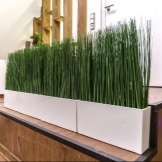

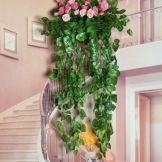
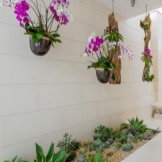
- In the kitchen bouquets or fresh flowers in pots are exposed to increased exposure to high temperatures, the influence of other negative factors. Is it any wonder that it is here that they are most often replaced by their artificial counterparts. Small forms are most relevant here - small vases and pots on shelves with spices, compact pots above the window and a low vase in the center of the table. Variations on the theme of field plants, herbs, sunflowers and herbs are welcome. In a country style, you can use bright rubber boots, old teapots, ceramic or wooden spice jars as containers.

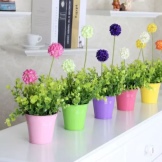
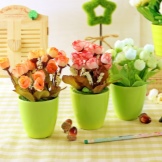
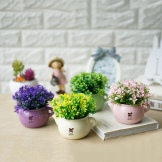
- In the living room, especially if the height of the ceilings allows, it is best to place floor flower arrangements. The interior with French windows will be decorated with a tall vase with calla lilies or orchids on both sides of the swing doors. It is better to leave amphorae in antique style white, complementing them with lush roses or strict gladioli. Home comfort in a Scandinavian style will help create begonias. For an eclectic space, it is better to choose a multi-tiered, staggered arrangement of elements - vases, baskets, pots and boxes.
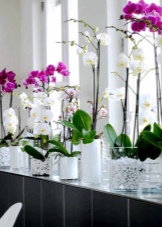

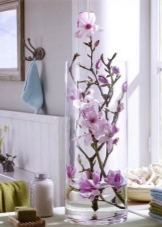
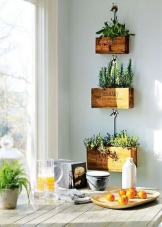
- Library is often an integral attribute of a country house with two floors and a staircase in the front part. Cypress trees in floor pots and even palm trees will be appropriate here, flowering apple trees and sakura trees will well complement a bonsai-style design. If you want brightness and freshness, you can use the railings and balusters of the stairs to create a personal "winter garden" even on a small object.

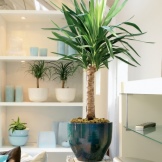
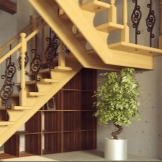
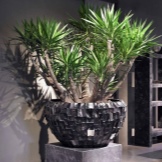
- For bedroom the best choice is considered to be artificial flowers of all shades of white - pink-creamy, fondant, caramel, milk rose or tulip petals, delicate peonies with tight buds. For a sunlit space, it is better to use crystal vases; in small rooms with a predominance of artificial light, low ceramic vases and flowerpots look nobler. In a room with a balcony, you can use large-format floor pots with lush rose bushes.
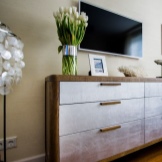
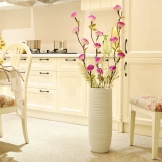
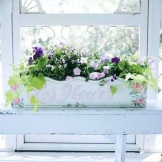
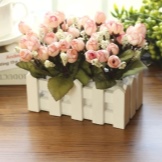
- In the bathroom flowers do not look very appropriate in the room of an ordinary apartment. In a country house, with a window and a bathtub in the center of the room, you can use compositions in a carefree Italian style or Provence aesthetics. Instead of pots, you can use painted wooden boxes filled with a lush mass of small flowers. Compositions in which flowers lie on water in low glass bowls are also appropriate here - separate shelves should be provided for them.
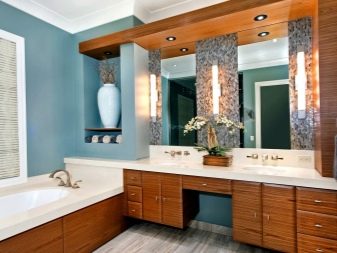
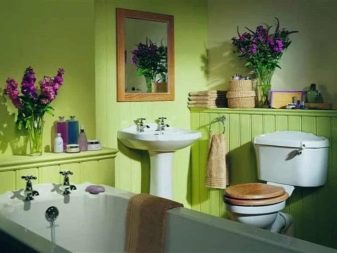
- Children's room can also be decorated with cute flower arrangements.It is better to choose options for pots with a wall mount of an unusual shape - in the form of an ice cream cone or an envelope. Plants with small flowers are suitable for decoration - forget-me-nots, chrysanthemums, clover.
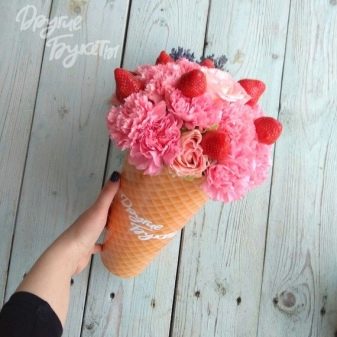
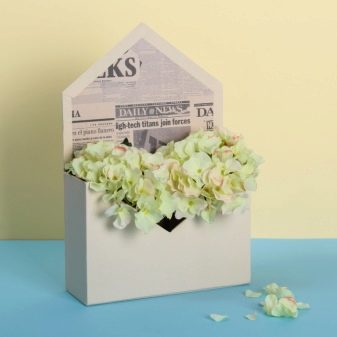
Basic materials and care
The modern approach to making artificial flowers requires the use of appropriate materials. It can be:
- silicone options that are as alive, especially in the form of peonies or roses with many petals;
- products with fabric petals are often satin, but cotton is also suitable;
- inflorescences from foamiran - when heated, they can be given any shape, the material is easy to tint;
- compositions in which paper leaves and petals are used;
- leather products;
- options sculpted from polymer clay.

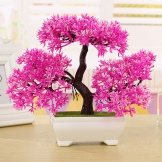
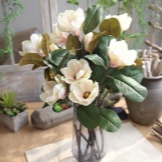
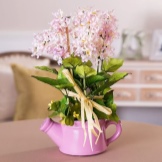
The rules for caring for artificial flowers in the interior are quite simple.
They are cleaned of dust with a special feather-based duster; it can also be blown off with a directed stream of cold air from a hair dryer. Smooth materials, such as polymer clay, are wiped with a damp cloth. Spraying is done periodically using a mixture of water and apple cider vinegar - this approach is possible for fabric formulations. Felt and satin flowers are washable.
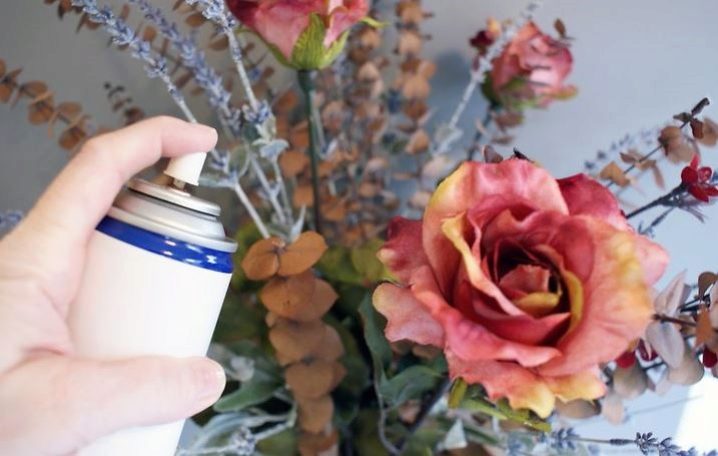
Successful examples
A striking example of a laconic calla lily composition in a cylindrical glass vase. Artificial flowers supplemented with water look so realistic that you involuntarily want to inhale their scent.

Delicate peonies are some of the most popular artificial flower options. The delicate color scheme allows you to favorably set off the space of the living room or bedroom with their help. The tabletop composition looks interesting and unusual in interior design.
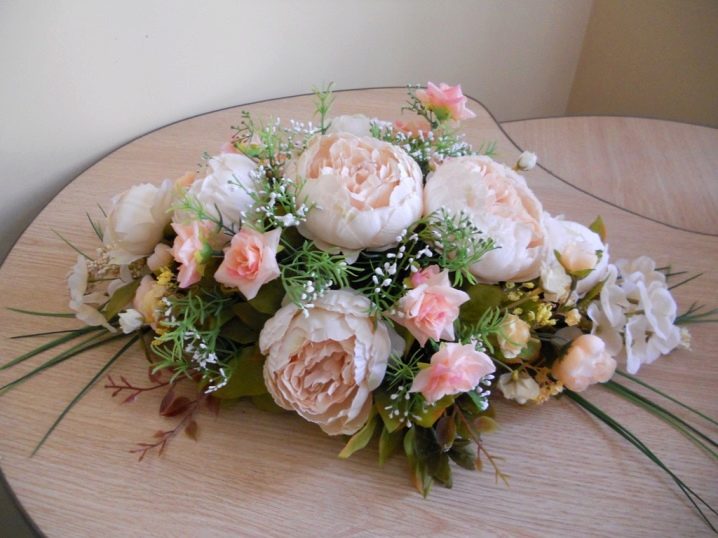
Tulips are the perfect choice for a modern country house or apartment. These artificial flowers really look like living ones and may well become a bright accent in a completely classic interior, enliven the minimalistic decor of a kitchen or study.
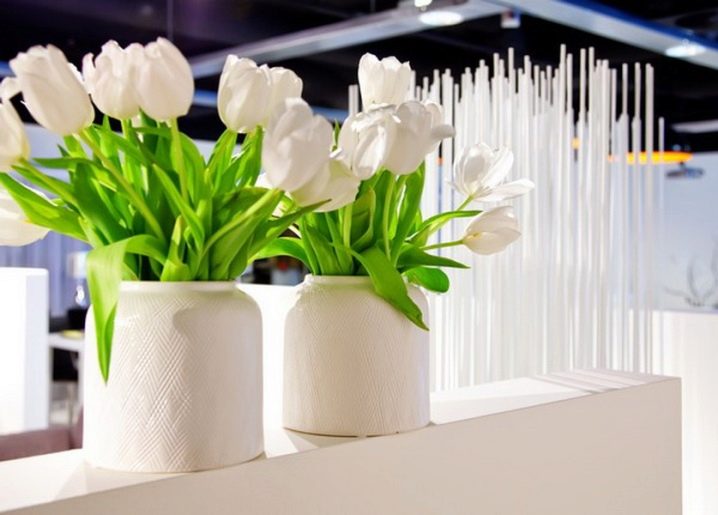
For information on how to make a bonsai with artificial flowers, see the next video.







































































































The comment was sent successfully.